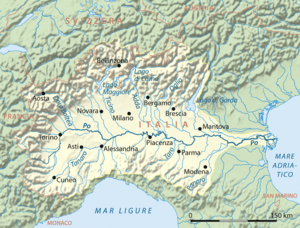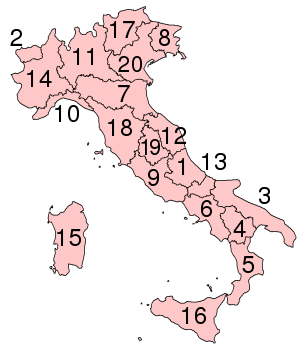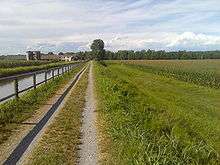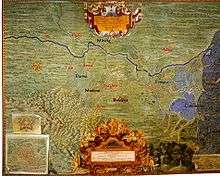Po Valley


The Po Valley, Po Plain, Plain of the Po, or Padan Plain (Italian: Pianura Padana [pjaˈnuːra paˈdaːna], Val Padana or Padania) is a major geographical feature of Italy. It extends approximately 650 km (400 mi) in an east-west direction, with an area of 46,000 square kilometres (18,000 sq mi) including its Venetic extension not actually related to the Po river basin; it runs from the Western Alps to the Adriatic Sea. The flatlands of Veneto and Friuli are often considered apart since they do not drain into the Po, but they effectively combine into an unbroken plain.
The plain is the surface of an in-filled system of ancient canyons (the "Apennine Foredeep") extending from the Apennines in the south to the Alps in the north, including the northern Adriatic. In addition to the Po and its affluents the contemporary surface may be considered to include the Savio, Lamone and Reno to the south, and the Adige, Brenta, Piave and Tagliamento of the Venetian Plain to the north, among the many streams that empty into the north Adriatic from the west and north.
Geo-political definitions of the valley depend on the defining authority. The Po Basin Water Board (Italian: Autorità di bacino del fiume Po), authorized in 1989 by Law no. 183/89 to oversee "protection of lands, water rehabilitation, the use and management of hydro resources for the national economic and social development, and protection of related environment" within the Po basin, has authority in several administrative regions of north Italy, including the plain north of the Adriatic and the territory south of the lower Po, as shown in the regional depiction included with this article. The law defines the Po basin as "the territory from which rainwater or snow and glacier melt flows on the surface, gathers in streams of water either directly or via tributaries...".[1] The United Nations Environment Program includes the Alps and Apennines as far as the sources of the tributaries of the Po but excludes Veneto and that portion of Emilia-Romagna south of the lower Po; that is, it includes the region drained by the Po but only the Po and its tributaries.[2]
The altitude of the valley through which the Po flows, exclusive of its tributaries, varies from approximately 4 m (13 ft) below sea level in the Polesine subregion (the delta around Ferrara)[3] to about 2,100 m (6,900 ft) at the river's origin in the southern Piedmontese province of Cuneo, also known as the Provincia granda. The valley is crossed by a number of affluents running down from the Alps in the north and from the Apennines in the south. The Po's major affluents include the Tanaro, Scrivia, Trebbia, Panaro and Secchia in the south, Dora Riparia, Dora Baltea, Sesia, Ticino (draining Lake Maggiore), Lambro, Adda (draining Lake Como), Oglio (draining Lake Iseo) and Mincio (draining Lake Garda and called Sarca in its upper reaches) in the north.
Geology
The Po Valley and the Adriatic overlay a foreland basin and a system of deeply buried ancient canyons surviving from the tectonic collision of an offshore land mass, Tyrrhenis, with the mainland, an incident within the collision of the African and Eurasian plates. Since the Messinian (7-5 mya) the system has been filling with sediment mainly from the older Apennines but also from the Alps. The shoreline of the Adriatic depends on a balance between the sedimentation rate and isostatic factors. Until about 1950 the Po delta was prograding into the Adriatic. After that time due to human alteration of geologic factors, such as the sedimentation rate, the delta has been degrading and the coastline subsiding, resulting in ongoing contemporaneous crises in the city of Venice, where much irreplaceable art and architecture is likely to be lost due to soaring sea level in the next centuries. Where the land surface now dips below sea level the river must run at a relative elevation between dikes.
The Malossa gas condensate field was discovered in 1973 and produces at depths of 6 km from the Upper Triassic Dolomia Principale dolomite and the Lower Jurassic Zandobbio dolomite, capped by the Lower Cretaceous Marne di Bruntino marl.[4]
Geography


The Po Valley is often regarded as a syncline, or dip in the crust due to compression at the edges. Regardless of whether this concept accurately describes its geology, the valley is manifestly a sediment-filled trough, or virtual syncline, continuous with the deeps of the Adriatic Sea. The surface terrain is therefore divided into two overall types of landform: the plain, or flat surface of the fill, and the anticline at the edges, taking the form of hilly country in which the outcrops of the original rock are visible along with alluvial fans formed from the outwash of the more severe anticlinal terrain; that is, the Apennines and the Alps.[5]
The valley is broadly divided into an upper, drier part, often not particularly suited for agriculture, and a lower, very fertile, and well irrigated section, known in Lombardy and western Emilia as la Bassa, "the low (plain)". The upper areas of the Po valley take local names which reflect in their meanings their being modestly suited for farming. So we have the Piedmontese vaude and baragge, the Lombard brughiere and Groane, or, exiting from the Po valley proper, the Friulian magredi, areas remote from easily reachable water tables and covered with dense woods or dry soils.
This specific meaning for "lower plain" derive from a geologic feature called the fontanili ("spring") line or zone, a band of springs around the Val Po, heaviest on the north, on the lowermost slopes of the anticline. It varies from a few kilometres to as much as 50 km (31 mi) wide. The fontanili line is the outcrop, or intersection, of the anticline's water table with the surface at the edge of the bassa. The rock above the line is porous. Surface water in the intermittent streams of the mountains tends to disappear below ground only to spring out again in the spring zone.[6] The spring zone is often called "the middle valley."
Surface runoff water (the Po and its affluents) is not of much value to the valley's dense population for drinking and other immediate uses, being unreliable, often destructive and heavily polluted by sewage and fertilizers. Its main anthropic value is for hydro-electric power, irrigation and industrial transport. The cost of purifying it for human consumption makes that process less feasible. The fresh drinking water comes from hundreds of thousands of wells concentrated especially in the fontanili zone. The major settlements therefore are also in that zone, which has become the centre of economic development and industry in Italy, and now is an almost continuous megalopolis stretching from Turin to Trieste.[7]
The bassa Padana was settled and farmed earliest, in Etruscan and Roman times, and has been completely devoted to agriculture since the Middle Ages, when efforts from monastic orders, feudal lords and free communes converged. The older and smaller cities deriving from ancient times are still located there.
Climate
The Po Valley has a mild continental climate and a humid subtropical climate, depending on the part of the valley one is referring to. Winters are foggy, damp and chilly, with sudden bursts of frost from the Siberian anticyclone; the urban heat effect has made them less foggy and cold than before. Snow is frequent but prolonged winter droughts increasingly deny sufficient moisture to the soil. Spring and autumn are well-marked and pleasant. Summer meanwhile can be a double-edged sword; many days are beautifully sunny with comfortable temperatures and cerulean clear skies, with some days being scorchingly hot, while other days can witness powerful, sudden hailstorms that have the potential to produce large hail, dump large quantities of rain, and be highly destructive to crops. Both winter and summer are more extreme in the lower parts along the Po, while the great lakes moderate the local climate around them. Wind is quite rare; only sudden bursts of foehn or thunderstorms manage to sweep the air clean. The almost enclosed nature of the Padan basin, indeed, added to the crushing weight of road traffic, makes it prone to a high level of pollution, especially in winter when cold air clings to the soil.
History
Prehistory and antiquity
Urban development began in the Po Valley much later than in Southern Italy or Greece. The first known ancient inhabitants of the thick forests and swamps were the Ligurians, an Indo-European race of people. After the progressive immigration in the 7th century BC of Celtic peoples known as the Insubres (hence the name of Insubria sometimes being given to northwestern Lombardy), the southern and central regions were conquered and colonised here and there by a pre-Indo-European people, the Etruscans, who left names such as Parma, Ravenna and Felsina, the ancient name of Bologna. The Etruscan domination left significant marks and introduced urban civilisation, but was short-lived. As the 5th century BC dawned, a new Celtic horde swarmed through the passes of the Western Alps and conquered most of the Po Valley. This invasion from the north did not reach Veneto, its inhabitants, the Venetics, likely being a distinct group who, being skilful merchants, were in time also culturally influenced by both Etruscans and Greeks.

The Gaulish conquerors, divided in major tribes as the Boii (from whom Bologna, Bononia, is named), the Taurini (whence the name of Turin), the Cenomani and the previous Insubres dwelled mostly on the plains, in time absorbing the Alpine populations. A warlike people, they even raided and burnt Rome itself in 390 BC under a leader named Brennus. Roman revenge took time, but was total and definitive: Celtic languages disappeared from northern Italy, replaced by Latin culture. This transformation occurred following the Romans' victory over the Gauls at the Battle of Clastidium and then Hannibal's final defeat at Zama. By 196 BC, Rome was master of the woody plains and soon displaced the Etruscans, dotting the region with bustling colonies, clearing the land, fighting the last rebel tribes and gradually imposing its own civilisation.
The centuries of Roman domination decided forever the main aspect of the Po Valley. Cities dotted the areas at the foothills of the Alps and Apennines in two stretches: in the south along the via Aemilia, in the north along the distance between Milan and Aquileia. Julius Caesar granted Roman citizenship to the peoples of these lands, whence he recruited many of his bravest troops. The Po Valley for a time hosted the capital of the Western Roman Empire, in Mediolanum from 286 to 403, and then in Ravenna until its political collapse. It was attacked in the 3rd century by Germanic tribes bursting through the Alps and sacked two centuries later by Attila the Hun. Led by their king Theoderic the Great, the Ostrogoths conquered the region from the north in the final years of the 5th century, deposing Odoacer, the barbarian ruler of Italy who had succeeded the last Western Roman emperor.
Middle Ages
The Gothic War and Justinian's plague devastated the Padan population. In this scenario of desolation, from which many people had fled to the mountains for safety (making them fairly populated till the 20th century) came the Germanic Lombards, a warrior people who gave their name to almost the whole of the Po valley: Lombardy. In the Middle Ages the term was used to indicate all of northern Italy. The Lombards divided their domain in duchies, often contending for the throne; Turin and Friuli, in the extreme west and east end respectively, seem to have been the most powerful, whereas the capital soon shifted from Verona to Pavia. Monza also was an important town in that time, more so than ruined Milan. The Lombards' harsh, caste-like rule over the natives softened somewhat with their conversion from Arianism to Catholicism.
The Lombard kingdom was overthrown in 774 by Charlemagne and his Frankish armies, becoming a prized part of the Carolingian Empire. The affirmation of large landownership from the eighth/ninth centuries accelerated the process of land reclamation and intensified land use, transforming the landscape of the Po Valley.[8] After the chaotic feudal dissolution of the empire and much fighting among pretenders to the imperial crown, Otto I of Saxony set the stage for the following phase of the region's history by adding the Po Valley to the Holy Roman Empire of the Germanic nation in 962. In Veneto, the lagoon capital of Venice, emerged a great sea power in alliance with its old master, the Byzantine Empire. In time the Comuni emerged, as towns thrived in commerce. Soon Milan became the most powerful city of the central plain of Lombardy proper, and despite being razed in 1162, it was a Milan-driven Lombard League with Papal benediction that defeated emperor Frederick Barbarossa at the Battle of Legnano in 1176.
Further civil wars escalated in the Guelph-Ghibelline reciprocate bloodbath of the 13th and 14th century. The Signorie came from spent out Communal institutions. With Venice's expansion on the eastern mainland in the first half of the 15th century and Milan's supremacy in the center and west the region (not significantly diminished by the Black Death of 1348) reached unprecedented peaks of prosperity. Vast areas were irrigated and cultivated with the most modern techniques available. The population averaged some 50 people per square kilometer, a very high standard for those times.
Early modern

In 1494, the ruinous Italian Wars began between France and Spain, which lasted for decades. Land changed hands frequently. Even Switzerland received some Italian-speaking lands in the north (Canton Ticino, not technically a part of the Padan region), and the Venetian domain was invaded, forcing Venice into neutrality as an independent power. In the end, Spain prevailed with Charles V's victory over Francis I of France at the Battle of Pavia in 1525.
The Spanish domination was oppressive, adding its burden to the Counterreformation imposed by the archbishopric of Milan; Protestantism was prevented from making inroads in the area. Burning at the stake became common practice during witchhunts, especially in the neighboring Alpine lands. During this bleak period, however, Lombard industry recovered, especially the textile branch, its pillar. When the War of Spanish Succession traded Milan to Austria, government and administration improved significantly. Though the peasantry began a century-long plunge into misery, cities prospered and grew.
When Napoleon I entered the Po Valley during some of his brightest campaigns (1796 and 1800, culminating in the historical Battle of Marengo), he found an advanced country and made it into his Kingdom of Italy. With Napoleon's final defeat the Austrians came back, but they were no more welcome. In the west,in Piedmont, the Savoy dynasty would emerge to serve as a springboard for Italian unification.
Late modern and contemporary
The Risorgimento, after an unsuccessful start in 1848 and 1849, triumphed ten years later in Lombardy, which was conquered by a Franco-Piedmontese army. In 1866 Veneto joined young Italy, thanks to Prussia's defeat of Austria. Poverty in the countryside increased emigration to the Americas, a phenomenon which subsided in the central region towards the end of the 19th century, but persisted in Veneto well into the 20th century. Industry grew rapidly, thanks to an abundance of water and literate manpower.
The World Wars did not significantly damage the area, despite the destruction caused by Allied aerial bombing of many cities and heavy frontline fighting in Romagna. The Resistance protected the main industries, which the Third Reich was using for war production, preventing their destruction: on the 25th of April, 1945 a general insurrection in the wake of the German defeat was a huge success. Most cities and towns, notably Milan and Turin, were freed by the partisans days before the Allies arrived.
After the war, the Padan area took the lead in the economic miracle of the 1950s and 60s. Since 1989, Lega Nord, a federation of Northern regionalist parties, has promoted either secession or larger autonomy for the Padan area which they call Padania.
Economy
The Po Valley is one of the most important industrial and agricultural areas in Italy. Hydroelectricity is produced by the flow of the Po. The river is extensively used for irrigation for the regions agriculture. [9]
References
- ↑ "The Po Basin Water Board, Italy". CABRI-Volga. Retrieved 4 June 2009.
- ↑ "Po". United Nations Environment Programme, Division of Early Warning and Assessment (DEWA), Global Resource Information Database (GRID) - Europe. Retrieved 4 June 2009.
- ↑ "the Water Board". Consorzio di Bonifica II Circondario - Polesine di San Giorgio. Retrieved 6 June 2009.
- ↑ Errico, G., Groppi, G., Savelli, S., and Vaghi, G.C., 1980, Malossa Field: A deep Discovery in the Po Valley, Italy, in Giant Oil and Gas Fields of the decade: 1968-1978, AAPG Memoir 30, Halbouty, M.T., editor, Tulsa: American Association of Petroleum Geologists, ISBN 0891813063, pp. 525-538
- ↑ Bridges, Edwin Michael (1990). World geomorphology. Cambridge; New York: Cambridge University Press. p. 225. ISBN 0521289653, ISBN 978-0-521-28965-8.
- ↑ Springs and spring watercourses: Springs in the Northern Italian plains (pdf). Italian Habitats. Italian Ministry of the Environment and Territory Protection / Ministero dell’Ambiente e della Tutela del Territorio, Friuli Museum of Natural History / Museo Friulano di Storia Naturale, Comune di Udine. 2002. ISBN 88-88192-04-2. Retrieved 6 June 2009.
- ↑ Jordan-Bychkov, Terry G.; Bella Bychkova Jordan (2001). The European culture area: a systematic geography (4, illustrated ed.). Lanham, MD: Rowman & Littlefield. p. 41. ISBN 0742516288, ISBN 978-0-7425-1628-1.
- ↑ Michele Campopiano, “Evolution of the Landscape and the Social and Political Organisation of Water Management: the Po Valley in the Middle Ages (Fifth to Fourteenth Centuries)”, in Borger, de Kraker, Soens, Thoen and Tys, Landscapes or seascapes? , (CORN, 13), 2013, 313-332 https://www.academia.edu/12164796/_Evolution_of_the_Landscape_and_the_Social_and_Political_Organisation_of_Water_Management_the_Po_Valley_in_the_Middle_Ages_Fifth_to_Fourteenth_Centuries_in_Borger_de_Kraker_Soens_Thoen_and_Tys_Landscapes_or_seascapes_CORN_13_2013_313-332
- ↑ "Po". Infoplease. Sandbox Networks, Inc., publishing as Infoplease. Retrieved 3 December 2015.
External links
| Wikimedia Commons has media related to Po Valley. |
- "Po Valley panorama map". Red Geographics. 2004–2009. Retrieved 3 June 2009.